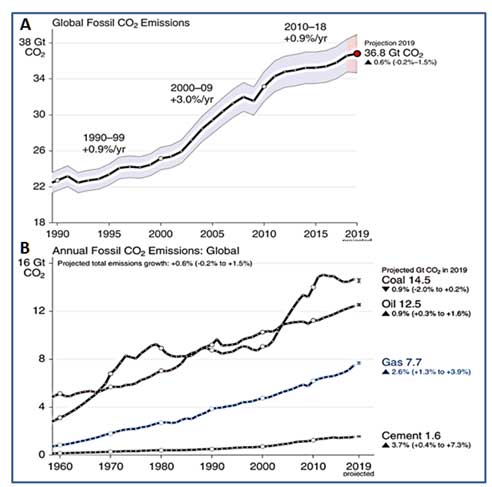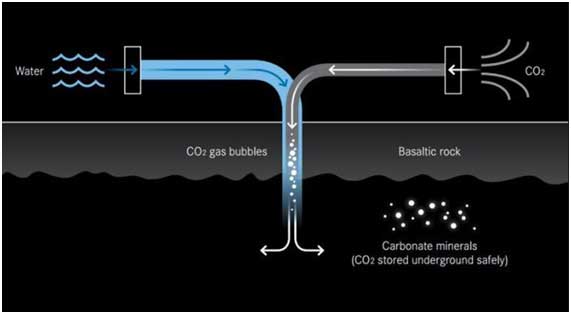Planetary arson
“Meeting the climate goals of the Paris Agreement is going to be nearly impossible without removing carbon dioxide from the atmosphere” Kevin Drum (2019). No one knows how to impose 1.5 or 2.0 degrees Celsius limits unless drawdown /carbon sequestration of atmospheric CO2 is attempted, nor are drawdown methods normally discussed in most political or economic forums.
The release of some 910 billion tons of carbon dioxide is leading human society, indeed much of nature, to an existential impasse. The widest chasm has developed between what climate science is indicating and between climate policies and negotiations controlled by governments, politicians, economists andjournalists—none of whom fully comprehends, or is telling the whole truth about, the full consequences of the current trend in the atmosphere-ocean-land system.
The evidence for future projections, as understood by climate scientists, has been largely put to one side, mainly because it is economically and politically “inconvenient” or is frightening. Reports from the Madrid climate COP-25 Conference suggest negotiations, focusing on emission reductions, are overlooking the evidence that at the current concentration of CO2, which have reached 412 ppm and496 ppm-equivalent[1], amplifying feedbacks from land and ocean are pushing temperatures further upwards.This is driven by the replacement of sea ice and land ice and snowsurfaces by open water surfaces, by methane leaks, desiccated vegetation, fires and reduced CO2 absorption by warming oceans.Given the long atmospheric residence time of CO2(Solomon et al. 2009, Eby et al. 2009) and the short life span of aerosols, attempts at CO2 drawdown are essential if complete devastation of the biosphere is to be avoided

Figure 1.(a) 1990-2019 Global growth of CO2 emissions (gigaton); (b) 1960-2019 Annual fossil CO2 emissions from coal, oil, Gas and cement (gigaton).

Figure 2(a) Distribution of global fires (NASA); (b) Fire storms over the southwest USA; (c) Pine forest fire California.
The prevailing political and economic focus in international climate projects, conferences and advisory councils is concerned with (a) limits on, or a decrease of, carbon emissions from power generation, industry, agriculture, transport and other sources; (b) limits on the current rise in global temperatures to +1.5 degrees Celsius, and a maximum of +2.0 degrees Celsius, above mean pre-industrial (pre-1750) temperatures.
However, no one knows how to impose these limits unless drawdown/sequestration of atmospheric CO2 is attempted, nor are drawdown methods normally discussed in most forums.
At the present the concentration of greenhouse gases of just under-500 ppm CO2-equivalentis activating amplifying feedbacksof greenhouse gases from land, oceans and melting ice sheets, namely further warming:
- An increase in evaporation due to warming of land and oceans leads to further warming due to the greenhouse effect of water vapor but also to increased cloudiness which retards warming. The water vapor factor, significant in the tropics, is somewhat less important in the dry subtropical zones and relatively minor inthe Polar Regions (Figure 3).
- The melting of ice sheets, reducing reflective (high-albedo) ice and snow surfaces, and concomitant opening of open water surfaces (heat absorbing low-albedo) is generating a powerful positive (warming) feedback. Hudson (2011) estimates the rise in warming due to total removal of Arctic summer sea ice as approximately +1.0 degrees Celsius.
- The release of methane from melting permafrost and bubbling of methane hydrates from the oceans has already raised atmospheric methane levels from about 800 to 1863 parts per billion which, given the radiative forcing of methane of X25< times,renders methane highly significant.
- As the oceans warm they become less capable of taking up carbon dioxide. As a result, more of our carbon pollution will stay in the atmosphere, exacerbating global warming.
- As tropical and subtropical climate zones overtake temperate Mediterranean-type climate zones, desiccated and burnt vegetation release copious amounts of carbon dioxide to the atmosphere. For example the current bushfires in Australia have already emitted 250 million tonnes of CO2, almost half of country’s annual emissions in 2018.

Figure 3.Total water vapor that can precipitate, as observed by the Atmospheric Infrared Sounder (AIRS) on NASA’s Aqua satellite.
With rising global temperatures and further encroachment of subtropical climate zones desertification and warming can only become more severe.
Abrupt reductions in emissions may be insufficient to stem global warming, unless accompanied by sequestration of greenhouse gases from the atmosphere, recommended as below 350 ppm CO2.According to Hansen et al. (2008)carbon sequestration in soil (the biochar method) has significant potential, applying pyrolysis of residues of crops, forestryand animal waste.Biochar helps soil retain nutrients and fertilizers, reducing release of greenhouse gases such as N2O. Replacing slash-and-burn agriculture with a slash-and-char method and the use of agricultural and forestry wastes for biochar production could provide a CO2 drawdown of ~8 ppm or more in half a century.
Stabilization and cooling of the climate could include two principle approaches (Table 1): (a) solar shielding, and (b) CO2 drawdown/sequestration. However, solar shielding by injected aerosols or water vapor is bound to be transient, requiring constant replenishment.
Table 1.Solar shielding and atmospheric CO2 sequestration methods
| Method | Supposed advantages | Problems |
| SO2 injections | Relatively cheap and rapid application | Short atmospheric residence time; ocean acidification; retardation of precipitation and of monsoons |
| Space satellite-mounted sunshades/mirrors | Rapid application. No direct effect on ocean chemistry | Longer space residence time. Does not mitigate ocean acidification by CO2 emissions. |
| Streaming of air through basalt and serpentine
(Figure 4)
| CO2 capture by Ca and Mg carbonates | In operation on a limited scale in Iceland. Significant potential |
| Soil carbon burial/biochar | Effective means of controlling the carbon cycle (plants+ soil exchange more than 100 GtC/year with the atmosphere) | Requires a collaborative international effort by millions of farmers. Significant potential |
| CO2 capture by sea weeds | An effective method applied in South Korea | Decay of sea weeds releases CO2 to ocean water.Significant potential |
| Ocean iron filing fertilization enhancing phytoplankton | CO2 sequestration | Phytoplankton residues would release CO2 back to the ocean water and atmosphere. |
| Ocean pipe system for vertical circulation of cold water to enhance CO2 sequestration | CO2 sequestration | Further warming would render such measure transient. |
| “Sodium trees” – pipe systems of liquid NaOH sequestering CO2 to sodium carbonate Na2CO3, followed by separation and burial of CO2. | CO2 sequestration, estimated by Hansen et al. (2008) at a cost of ~$200/ton CO2 where the cost of removing 50 ppm of CO2 is ~$20 trillion. | Unproven efficiency; need for CO2 burial; $trillions expense, though no more than the military expenses since WWII. |

Figure 4.Iceland: The streaming of CO2-containing air and of water through basaltic rocks and CO2-capture as carbonate minerals.
The big question is how effective are the above methods in reducing CO2 levels on a global scale, at the very least to balance emissions, currently 36.8 billion tons CO2 per year.Whereas each of the methods outlined in Table 1 has advantages and disadvantages, it is hard to see an alternative way of cooling the atmosphere and oceans than a combination of several of the more promising methods.Budgets on a scale of military spending ($1.7 trillion in 2017) are required in an attempt to slow downthe current trend across climate tipping points. The choice humanity is facing is whether to spend resources on this scale on wars or on defense from the climate calamity.
Time is running out.
Andrew Glikson, Earth and climate scientist, Australian National University
[1]when the CO2-equivalents of methane and nitrous oxide are included

0 Comments:
Post a Comment
Subscribe to Post Comments [Atom]
<< Home